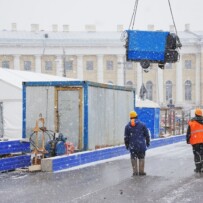
It’s December and for those of us in cold climates, it is time to be thinking again about winter safety. Here are some things to keep in mind.
Winter Fall Safety
Falls are always a concern for roofers, but when you add ice and snow to the mix, your crew must be prepared. In addition to all of your normal fall prevention procedures, make sure to warn your crew that a layer of snow can be covering a dangerous ice layer. Make them aware that deep snow can cover trip hazards such as conduits and pipes. Drifting snow can also cover skylights, so have the building management point out their locations to your crew prior to them getting onto the roof. Set up safety guard rails on the parameters of the roofs for added protection. Remember to check ladder rungs for ice prior to use.
Proper Clothing to Protect against Hypothermia or Frostbite
Make sure your crew members are wearing appropriate clothes for the temperature and conditions. Don’t assume that they all know what to wear. Hypothermia or frostbite are real possibilities in cold weather and must be taken seriously. The Occupational Safety and Health Administration (OSHA) recommends the following:
- Wear at least three layers of loose-fitting clothing. Layering provides better insulation.
- An inner layer of wool, silk or synthetic (polypropylene) material to keep moisture away from the body. These are materials that will hold more body heat than cotton.
- A middle layer of wool or synthetic to provide insulation even when wet.
- An outer wind and rain protection layer that allows some ventilation to prevent overheating.
- Do not wear tight-fitting clothing that reduces blood circulation. Warm blood needs to circulate to the extremities.
- Insulated coat/jacket (water resistant, if necessary).
- Knit mask to cover face and mouth (if needed).
- Wear a hat that will cover your head as well as your ears. Hats reduce the amount of body heat that escapes from your head and will help keep your whole body warmer.
- Wear insulated gloves (water-resistant, if necessary) to protect the hands.
- Insulated and waterproof boots to protect the feet.
Also, suggest to your crew members to have a change of clothes since they could get damp from the snow and their sweat from working. Sunglasses may also be useful to help prevent snow blindness.
Understanding Wind Chill
Everyone knows that wind chill is referring to the wind making the actual temperature feel colder. However, the wind is more than just a comfort issue – it actually carries heat away from your body, speeding up the risk of frostbite. The National Oceanic and Atmospheric Administration (NOAA) has a chart that relates wind chill to frostbite times, which you can download. Keep taps on the wind chill so you can protect your crew.
Take a little extra time and make sure your crew is prepared for the onslaught of cold weather. GenFlex wants you and your crew to stay safe this winter.
